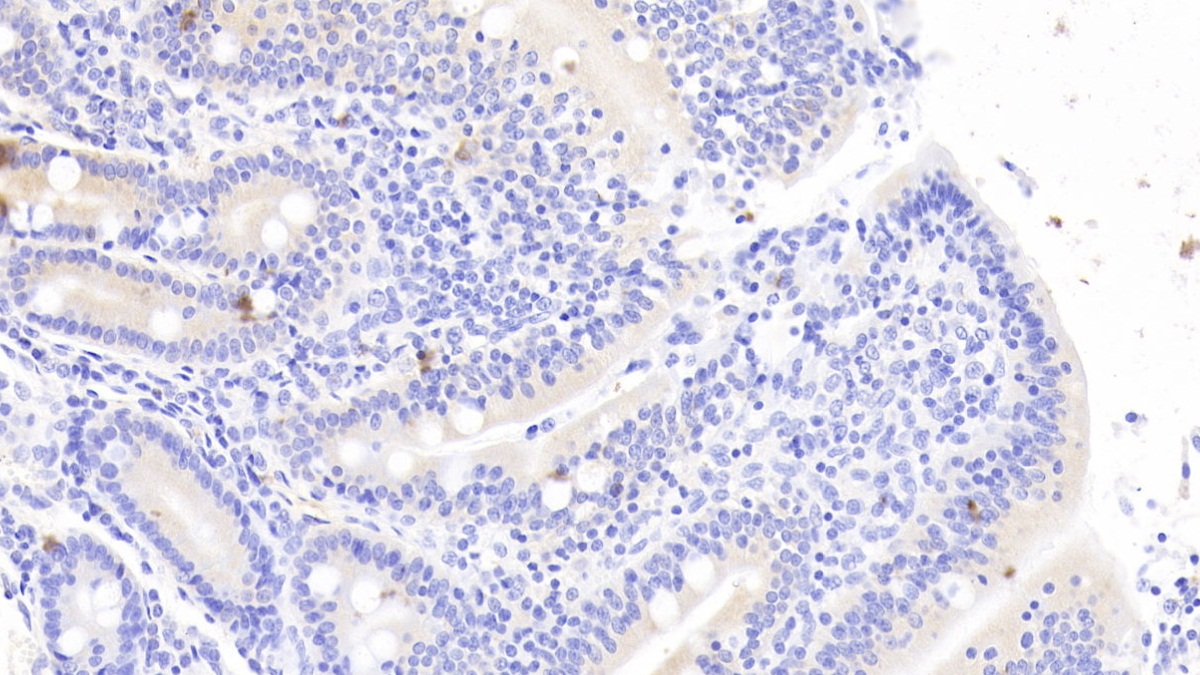Monoclonal Antibody to Neurotensin (NT) 

NTS; NTS1; NmN-125; NN; Tail peptide Neuromedin N
Overview
Properties
- Product No.MAB203Hu22
- Organism SpeciesHomo sapiens (Human) Same name, Different species.
- ApplicationsIHC
If the antibody is used in flow cytometry, please check FCM antibodies.
Research use only - DownloadInstruction Manual
- CategoryReproductive scienceNeuro scienceHormone metabolism
- SourceMonoclonal antibody preparation, Host Mouse
- Ig Isotype IgG1 Kappa, Clone Number C5
- PurificationProtein A + Protein G affinity chromatography
- LabelNone
- Immunogen RPB203Hu02-Recombinant Neurotensin (NT)
- Buffer Formulation0.01M PBS, pH7.4, containing 0.05% Proclin-300, 50% glycerol.
- TraitsLiquid, Concentration 1mg/mL
Sign into your account
Share a new citation as an author
Upload your experimental result
Review

Contact us
Please fill in the blank.
Specifity
The antibody is a mouse monoclonal antibody raised against NT. It has been selected for its ability to recognize NT in immunohistochemical staining and western blotting.
Usage
Western blotting: 0.01-2µg/mL;
Immunohistochemistry: 5-20µg/mL;
Immunocytochemistry: 5-20µg/mL;
Optimal working dilutions must be determined by end user.
Storage
Store at 4°C for frequent use. Stored at -20°C in a manual defrost freezer for two year without detectable loss of activity. Avoid repeated freeze-thaw cycles.
Stability
The thermal stability is described by the loss rate. The loss rate was determined by accelerated thermal degradation test, that is, incubate the protein at 37°C for 48h, and no obvious degradation and precipitation were observed. The loss rate is less than 5% within the expiration date under appropriate storage condition.
Giveaways
Increment services
-
 Antibody Labeling Customized Service
Antibody Labeling Customized Service
-
 Protein A/G Purification Column
Protein A/G Purification Column
-
 Staining Solution for Cells and Tissue
Staining Solution for Cells and Tissue
-
 Positive Control for Antibody
Positive Control for Antibody
-
 Tissue/Sections Customized Service
Tissue/Sections Customized Service
-
 Phosphorylated Antibody Customized Service
Phosphorylated Antibody Customized Service
-
 Western Blot (WB) Experiment Service
Western Blot (WB) Experiment Service
-
 Immunohistochemistry (IHC) Experiment Service
Immunohistochemistry (IHC) Experiment Service
-
 Immunocytochemistry (ICC) Experiment Service
Immunocytochemistry (ICC) Experiment Service
-
 Flow Cytometry (FCM) Experiment Service
Flow Cytometry (FCM) Experiment Service
-
 Immunoprecipitation (IP) Experiment Service
Immunoprecipitation (IP) Experiment Service
-
 Immunofluorescence (IF) Experiment Service
Immunofluorescence (IF) Experiment Service
-
 Buffer
Buffer
-
 DAB Chromogen Kit
DAB Chromogen Kit
-
 SABC Kit
SABC Kit
-
 Long-arm Biotin Labeling Kit
Long-arm Biotin Labeling Kit
-
 Real Time PCR Experimental Service
Real Time PCR Experimental Service
Citations
- Colonic Transit Time and Gut Peptides in Adult Patients with Slow and Normal Colonic Transit Constipationpubmed:29082242
- Inhibition of Peroxynitrite-induced mitophagy activation attenuates cerebral ischemia-reperfusion injuryPubmed:29307080
- Adipose Tissue-Derived Biomarkers of Intestinal Barrier Functions for the Characterization of Diarrhoea-Predominant IBS
- Functional analysis of gut microbiota and immunoinflammation in children with autism spectrum disordersPubmed: 31320306
- Association between Circular RNA CDR1as and Post-Infarction Cardiac Function in Pig Ischemic Heart Failure: Influence of the Anti-Fibrotic Natural Compounds …Pubmed: 32823854
- Qiliqiangxin Improves Cardiac Function through Regulating Energy Metabolism via HIF-1α-Dependent and Independent Mechanisms in Heart Failure Rats …Pubmed: 32626732
- Identification of U-shaped Curve Relation in Pro-neurotensin and Risk of Coronary Artery Disease (CAD) in Premature CAD Patients
- Effect of dobutamine on intrinsic myocardial function and myocardial apoptosis in septic rats with myocardial dysfunction
- Harmine is an effective therapeutic small molecule for the treatment of cardiac hypertrophy33785860
- Elabela gene therapy promotes angiogenesis after myocardial infarction34291565
- Renal Impairment Detectors: IGFBP-7 and NGAL as Tubular Injury Markers in Multiple Myeloma Patients34946293






